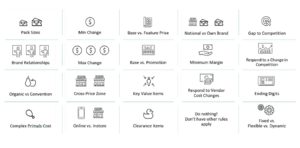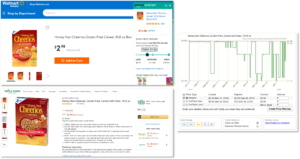Why is pricing your goods to win against the competition a must do? Consumer goods retail is in the midst of an evolutionary era marked by rapid, ongoing change; change that hasn’t spared retailers’ pricing strategies. From ballooning inflationary pressures to the explosion in online retail, pricing strategies (like competitive pricing tactics) have proven to be key strategic levers in a retailer’s ability to adapt. This constant change has made managing competition based pricing, not to mention a retailer’s comprehensive pricing strategy, even more complicated. How can retailers effectively execute a pricing strategy amidst these challenges? Let’s dive in.
1. What is competitive pricing?
2. Why is competitive pricing important?
3. Managing competitive pricing as part of your larger strategy
4. Three key takeaways
1. What is Competitive Pricing?
Competitive pricing is the component of a retailer’s comprehensive pricing strategy that is sensitive to how its competitors change pricing in the same market for the same goods, addressing the same market pressures, and prescribes how a retailer’s prices should change (and not change) in accordance.
For example, let’s say Retailer A has a price set for a popular product in its stores, with rules governing what the price should be with respect to competing retailers’ prices for the same product. When a competing retailer changes the price of that product, Retailer A must then also change its price to stay within the range of acceptable prices in comparison to its competitors, as prescribed by their competitive pricing rules.
Adjustments in response to competitive activity don’t happen in a vacuum; when a competing retailer changes its price for a product that comes in a variety of sizes, pack size rules come into play. In that scenario, not only does Retailer A need to adjust price with respect to competitive activity, it also needs to adjust price with respect to other pack sizes so customers still see logical value in buying larger sizes vs medium sizes, and so on.
This is an isolated example of the interplay between rules within a comprehensive pricing strategy; take that and apply it to thousands of products, each with their own set of dozens of rules, and you will get a sense of the complexity retailers are facing. These robust sets of rules need to be guided by an intelligent pricing strategy and managed by an intelligent pricing system.
Retailers’ Robust Pricing Rules are Complex Interconnected

Retailers can take many angles of approach when creating a comprehensive pricing strategy, from cost based pricing, to value based pricing, to competition based pricing. But grouping pricing strategy into buckets like these is a massive oversimplification of a retailer’s pricing strategy. Often, it includes all of these in some measure. Retailers have a complex, expansive set of pricing rules that cover everything from competitive pricing to cost changes, to national versus own brand, to online versus instore, and much, much more—and the Eversight Retail Pricing Suite is built with a robust rules set that forms the foundation of a complete price management system that can handle it all.
2. Why is Competitive Pricing Important?
Why should retailers care about competitive pricing when there are many other facets of a comprehensive pricing strategy that retailers need to factor in when setting the pricing rules that govern its pricing architecture and strategy? Because the opportunity to engage shoppers, remain relevant, and drive revenue is left on the table when retailers do not establish a conscious strategy and purposeful approach to competitive pricing.
As a starting point, to have an effective competitive pricing strategy a retailer needs to have a finger on the pulse of its competitors’ price changes. Once that is established, the big challenge merchants face is managing hundreds of thousands of prices across just as many product groups within the confines of a comprehensive pricing strategy—and finding the bandwidth to continually revisit its pricing structure to react to a competitor’s changes. No human alone can manage the complex layers of those price changes internally in concert with their competitors’ ongoing activity.
Shoppers Have More Price Visibility Than Ever Before; Smartphones Enable Seamless Comparison Shopping
A retailer’s approach and toolset to maximizing its comprehensive pricing strategy can be just as much of a competitive advantage as a competitive pricing strategy itself. But by no means is managing this an easy feat for a retailer or their merchants—it requires vigilance and agility, and the inherent need to improve upon past performance while still respecting the rules set by the pricing strategy. And that’s where technology comes in.
3. Managing Competitive Pricing as Part of Your Larger Strategy
For a retailer and its merchants to effectively inform and guide strategy for future growth and success, new technology needs to be adopted to manage comprehensive pricing strategies. This includes competitive pricing, in concert with an entire robust pricing rules set. It means breaking free from spreadsheets, mitigating the risk of human error or relying on shortcuts, and giving merchants the ability to do their work proactively with a tool guiding them through effective responses to market pressures and changes.
Why do you need a competition based pricing strategy now? In the current environment, merchants are being tasked with having to navigate inflation and cost of goods challenges without time to assess the impact of those changes. In addition, they have to evaluate what their competitors are doing with limited visibility into how those changes can be managed long term – all while maintaining brand sentiment with consumers at the center of each decision. We built the Eversight Retail Pricing Suite solution around these real-world operational considerations.

Retailers factor in an incredible amount of data when creating a competitive pricing strategy. It is critical that a retailer’s work defining its competitive pricing strategy actually translates to the prices that are live in its stores. Remember, your insights are only as valuable as your ability to act on them. For retailers tapped into the Eversight Retail Pricing Suite, this means having insights delivered in real-time that forecast the impact of price changes to the business, exceptions-based workflows that give merchants and pricing analysts the ability to only focus on the highest priority changes, and AI that intricately manages the full rules portfolio, efficiently reconciling violations and ensuring that prices in stores match pricing strategies.
4. Key Takeaways
So what does this all boil down to? Let’s sum it up with what retailers really need to know when it comes to competitive pricing today:
1. Having a finger on the pulse of your competitors’ price changes is an absolute requirement before you can even begin to craft an effective competitive pricing strategy.
2. Think through the approach and toolset you deploy to maximize your comprehensive pricing strategy – they can be just as much of a competitive advantage as the strategy itself.
3. Insights are only as valuable as your ability to act on them. It is critical that your work defining your competitive pricing strategy actually translates to the prices that are live in your stores.
The dynamics of competitive pricing are complex, ever changing, and highly influenced by what is happening in the broader economic environment and in the lives of consumers. But with the right strategies, pricing tools, and technology partners, competitive pricing can become not only manageable, but core to a successful broader pricing strategy.
